
Cast * Interesting Facts * The Music * Origins of The Prince of Egypt

Cast * Interesting Facts * The Music * Origins of The Prince of Egypt
Directed by: Brenda Chapman & Steve
Hickner
Written by: Philip LaZebnik
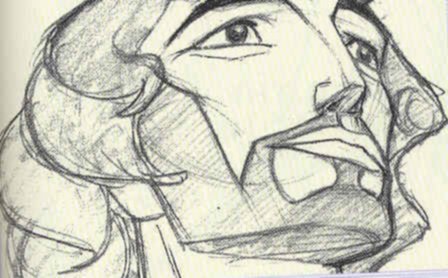 Music
by: Hans Zimmer & Stephen Schwartz
Music
by: Hans Zimmer & Stephen Schwartz
Released on: December 18, 1998
Running Time: 97 minutes
Budget: $60 million
U.S. Opening Weekend: $14.524 million
over 3,118 screens
Box-Office: $101.2 in the U.S., $221.3
million worldwide
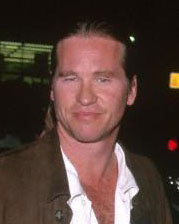 |
 |
 |
 |
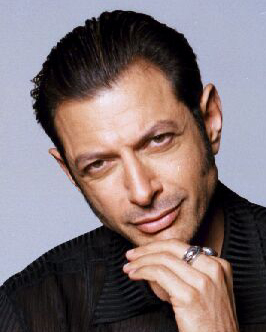 |
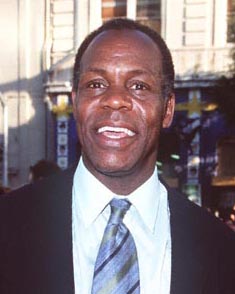 |
 |
 |
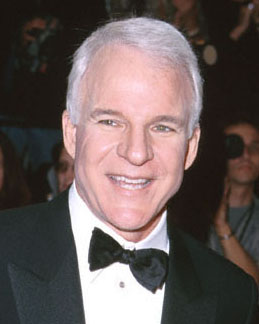 |
 |
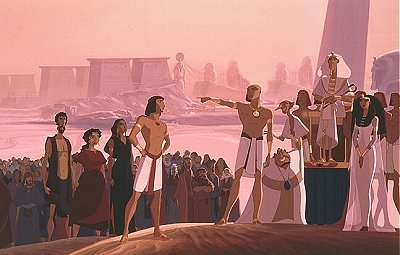 Moses/God...
Val Kilmer
Moses/God...
Val Kilmer
Ramese... Ralph Fiennes
Tzipporah... Michelle Pfeiffer
Miriam... Sandra Bullock
Aaron... Jeff Goldblum
Jethro... Danny Glover
Pharao Seti I... Patrick Stewart
The Queen... Helen Mirren
Hotep... Steve Martin
Huy... Martin Short
Yocheved... Ofra Haza
Mel Brooks
![]() The production
team is headed by directors Brenda Chapman, the first woman director of
an animated feature, Steve Hickner and Simon Wells.
The production
team is headed by directors Brenda Chapman, the first woman director of
an animated feature, Steve Hickner and Simon Wells.
![]() The Prince
of Egypt was conceived, according to the DreamWorks founding trio,
during the initial burst of excitement of inventing the company in 1994.
In a meeting at Steven Spielberg's house, the talk turned to animation.
Spielberg said he wanted to do a project with the grandeur of The Ten Commandments.
"What a great idea," David Geffen said. "Let's do it."
The Prince
of Egypt was conceived, according to the DreamWorks founding trio,
during the initial burst of excitement of inventing the company in 1994.
In a meeting at Steven Spielberg's house, the talk turned to animation.
Spielberg said he wanted to do a project with the grandeur of The Ten Commandments.
"What a great idea," David Geffen said. "Let's do it."
![]() Jeffrey Katzenberg
didn't recognize the risks of treading on such literally sacred ground:
"It is so much more complicated, so much more challenging than simply making
a movie." The voice of God was one of the more difficult choices in the
film. "Every race and color and creed has a claim to the voice of God,"
Katzenberg says. Using an idea of producer Cox's, the animators put together
a scratch track that was an eerily effective chorus of every character
in the film, with the dominant voice morphing from man to woman to child.
But consultant Schwartz-Getzug vetoed that approach, saying some people
would be offended if the voice of God sounded--even momentarily--like a
woman's (Val Kilmer ended up supplying the voice).
Jeffrey Katzenberg
didn't recognize the risks of treading on such literally sacred ground:
"It is so much more complicated, so much more challenging than simply making
a movie." The voice of God was one of the more difficult choices in the
film. "Every race and color and creed has a claim to the voice of God,"
Katzenberg says. Using an idea of producer Cox's, the animators put together
a scratch track that was an eerily effective chorus of every character
in the film, with the dominant voice morphing from man to woman to child.
But consultant Schwartz-Getzug vetoed that approach, saying some people
would be offended if the voice of God sounded--even momentarily--like a
woman's (Val Kilmer ended up supplying the voice).
![]() It quickly became
clear that certain elements typical of Disney-style animated films would
be out of place. A talking camel was cut. Comics Steve Martin and Martin
Short, cast as charlatan priests, were directed to turn in subdued performances.
Lucrative tie-ins were another sensitive issue. Katzenberg says, semiseriously,
"We came up with the Red Sea boogie board. We had the 40-years-in-the-desert
water bottle. We had the parting-of-the-Red-Sea shower curtain." But ultimately,
both DreamWorks and its partner Burger King concluded that they would be
doing themselves "a terrible disservice" if they pushed any kind of merchandise
that would trivialize the film. Moses action figures were out. Instead,
DreamWorks came up with a Wal-Mart package containing tickets to the film,
a souvenir book and a sampler CD.
It quickly became
clear that certain elements typical of Disney-style animated films would
be out of place. A talking camel was cut. Comics Steve Martin and Martin
Short, cast as charlatan priests, were directed to turn in subdued performances.
Lucrative tie-ins were another sensitive issue. Katzenberg says, semiseriously,
"We came up with the Red Sea boogie board. We had the 40-years-in-the-desert
water bottle. We had the parting-of-the-Red-Sea shower curtain." But ultimately,
both DreamWorks and its partner Burger King concluded that they would be
doing themselves "a terrible disservice" if they pushed any kind of merchandise
that would trivialize the film. Moses action figures were out. Instead,
DreamWorks came up with a Wal-Mart package containing tickets to the film,
a souvenir book and a sampler CD.
![]() Jeffrey Katzenberg
circled the globe during the weeks preceeding the movie's release--visiting
fifteen countries in three weeks, and more than 50 overall. He met with
nearly 700 clerics and scholars, journeyed to the Vatican, and addressed
groups ranging from some faculty members of the Harvard divinity school
(to seek their wisdom) to 4,000 Wal-Mart employees in Texas (to inspire
them to sell a special Prince of Egypt promotional package).
Jeffrey Katzenberg
circled the globe during the weeks preceeding the movie's release--visiting
fifteen countries in three weeks, and more than 50 overall. He met with
nearly 700 clerics and scholars, journeyed to the Vatican, and addressed
groups ranging from some faculty members of the Harvard divinity school
(to seek their wisdom) to 4,000 Wal-Mart employees in Texas (to inspire
them to sell a special Prince of Egypt promotional package).
![]() This was Ofra
Haza's last picture. She died of AIDS complication in March 2000.
This was Ofra
Haza's last picture. She died of AIDS complication in March 2000.
![]() The November 2000
made-for-video musical animated sequel, Joseph: King of Dreams features
the voice talent of Jodi Benson (The
Little Mermaid's Ariel), Ben Affleck, Mark Hamill, Steven Weber
and Judith Light. The 75-minute movie,
The November 2000
made-for-video musical animated sequel, Joseph: King of Dreams features
the voice talent of Jodi Benson (The
Little Mermaid's Ariel), Ben Affleck, Mark Hamill, Steven Weber
and Judith Light. The 75-minute movie, 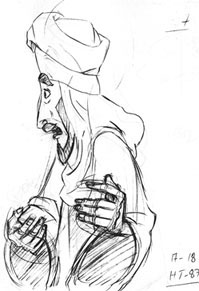 three
years in the works -even before The Prince of Egypt!- was completed
in April 2000. Kelley Avery, worldwide head of DreamWorks Home Entertainment,
said the undisclosed budget was comparable to the highest quality made-for-video
movies -budgets for some made-for-video titles such as The Return of
Jafar and Aladdin: King of Thieves have exceeded $10 million,
according to estimates by industry sources. Although Avery would
not say if the studio has committed to any other productions to premiere
on video yet, she did say it was possible that the studio would consider
producing annual made-for-video productions that could be other Bible-related
stories or extensions of studio films.
three
years in the works -even before The Prince of Egypt!- was completed
in April 2000. Kelley Avery, worldwide head of DreamWorks Home Entertainment,
said the undisclosed budget was comparable to the highest quality made-for-video
movies -budgets for some made-for-video titles such as The Return of
Jafar and Aladdin: King of Thieves have exceeded $10 million,
according to estimates by industry sources. Although Avery would
not say if the studio has committed to any other productions to premiere
on video yet, she did say it was possible that the studio would consider
producing annual made-for-video productions that could be other Bible-related
stories or extensions of studio films.
Oscar winner Stephen Schwartz (Pocahontas) wrote six original songs for the film, with composer Hans Zimmer, an Academy Award winner for his work on The Lion King.
Composer and Lyricist Stephen Schwartz began working on writing songs for the movie at the very beginning of the project. From that point on, as the story evolved, he continued to write songs that would serve to both entertain and help move the story along. Composer Hans Zimmer arranged and produced the songs and then eventually wrote the score. The score for The Prince of Egypt was recorded entirely in London, England.
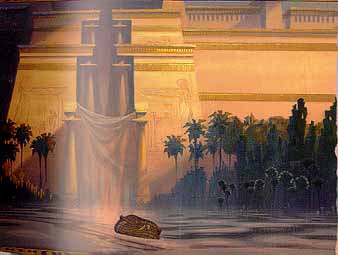 The
song "When You Believe" had its roots in the research trip to the Middle
East. Finkelman Cox notes, "Steve Hickner, Stephen Schwartz and I
were riding through the Egyptian desert when we came up with the idea for
a song that would represent optimism in the wake of the devastation of
the plagues." Stephen Schwartz reveals that "the song began to form
in my head looking up at Mount Sinai and hearing the echoes of history.
Then in my research, I came across the words to a song that the Hebrews
were supposed to have sung after coming through the Red Sea, 'Ashira l'Adonai,'
loosely meaning 'I sing a song of praise to the Lord.' I thought it would
be nice if the children who were free for the first time in their lives
sang this song of praise and joy in Hebrew in the middle of 'When You Believe.'"
The
song "When You Believe" had its roots in the research trip to the Middle
East. Finkelman Cox notes, "Steve Hickner, Stephen Schwartz and I
were riding through the Egyptian desert when we came up with the idea for
a song that would represent optimism in the wake of the devastation of
the plagues." Stephen Schwartz reveals that "the song began to form
in my head looking up at Mount Sinai and hearing the echoes of history.
Then in my research, I came across the words to a song that the Hebrews
were supposed to have sung after coming through the Red Sea, 'Ashira l'Adonai,'
loosely meaning 'I sing a song of praise to the Lord.' I thought it would
be nice if the children who were free for the first time in their lives
sang this song of praise and joy in Hebrew in the middle of 'When You Believe.'"
"The first time I heard the song, I knew Stephen had accomplished everything we had talked about that day in Egypt," Finkelman Cox affirms. "'When You Believe' embodies all the hope of the human spirit, and the ability to recover from enormous adversity and walk forward to a better life if you hold on to your faith and your dreams."
The original lyrics "You can do miracles when you believe" were changed
to "There can be miracles when you believe," to avoid the implication that
you (not God) can work miracles. Stephen Schwartz comments that this was
done "because of objections from the representatives of more conservative
religious groups (They felt the line implied that humans can do actual
miracles, not just God; as with their interpretation of the Bible itself,
they took everything literally with no sense whatsoever of metaphor.)"
Additionally, the lyricist "took three passes at a song for the spot which
ultimately became "Through Heaven's Eyes" (by far the best of the songs
I wrote for that spot.) There was one song I was sorry didn't make it into
the film -- a song for Moses and Rameses called "Brotherly Love" that occurred
at the banquet in the early part of the film and which helped to establish
their relationship. It was felt that the chariot race which preceded it
essentially did the same thing, and for length reasons, the song was eliminated."
THE ORIGINS OF THE PRINCE OF EGYPT
The idea that would become DreamWorks' The Prince of Egypt began to take shape even before the company was formed. Of course, the story has its roots in the biblical book of Exodus, but the inspiration to bring it to the screen as the studio's first traditionally animated feature arose unexpectedly from a conversation between Jeffrey Katzenberg, Steven Spielberg and David Geffen back in 1994.
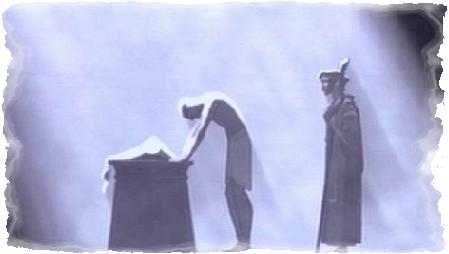 The
three were talking about their ambitions for their as-yet-to-be-announced
studio venture. Katzenberg's revolved around a new animation studio, which
prompted a question from Spielberg. Katzenberg recalls, "Steven asked what
the criteria would be for a great animated film, and I launched into a
20-minute dissertation about what you look for: a powerful allegory that
we can relate to in our time; extraordinary situations to motivate strong
emotional journeys; something wonderful about the human spirit; good triumphing
over evil; music as a compelling storytelling element; and so on… Steven
leaned forward and said, 'You mean like "The Ten Commandments"?,' and I
said, 'Exactly.'"
The
three were talking about their ambitions for their as-yet-to-be-announced
studio venture. Katzenberg's revolved around a new animation studio, which
prompted a question from Spielberg. Katzenberg recalls, "Steven asked what
the criteria would be for a great animated film, and I launched into a
20-minute dissertation about what you look for: a powerful allegory that
we can relate to in our time; extraordinary situations to motivate strong
emotional journeys; something wonderful about the human spirit; good triumphing
over evil; music as a compelling storytelling element; and so on… Steven
leaned forward and said, 'You mean like "The Ten Commandments"?,' and I
said, 'Exactly.'"
However, it was Geffen who brought the concept home, as Katzenberg remembers, "David said, 'What a great idea. Why don't we make that our first animated movie?' And we were off…"
During the early stages of production, key members of the creative team embarked on a trip to Egypt and the Sinai Peninsula. Songwriter Stephen Schwartz observes, "It's hard to define, but there's an intangible connection that comes from being on the actual spot… seeing the locations and breathing the air. There were times when I was walking through a temple or looking at a giant statue and music would actually come into my head. Several themes in the movie originated that way."
The filmmakers recognized that there were a number of inherent challenges in bringing the Exodus story to the screen. Producer Sandra Rabins offers, "We began by identifying the problems, and then set out to solve them during an 18-month evolution in which we continually honed the story to discover what worked and what didn't."
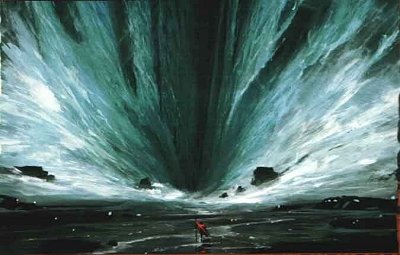 The
first dilemma was how to tell a story of such enormous scope in about 90
minutes. Co-story supervisor Kelly Asbury says, "The challenges were to
be as true to the biblical source material as possible, maintain the overall
narrative of the story, capture the emotions of the characters, and make
a film you could really sink your teeth into-all within the time constraints."
The
first dilemma was how to tell a story of such enormous scope in about 90
minutes. Co-story supervisor Kelly Asbury says, "The challenges were to
be as true to the biblical source material as possible, maintain the overall
narrative of the story, capture the emotions of the characters, and make
a film you could really sink your teeth into-all within the time constraints."
Co-head of story Lorna Cook continues, "It was also important to keep the character of Moses as accessible as possible, because ultimately he was human. That was one thing we wanted to get across: he wasn't just a messenger; he was a man who took on a mission, but not without conflict and sometimes with a lot of fear."
Katzenberg says, "When we were recruiting, people would come in, and I'd show them the Doré illustrated Bible, a book of Monet paintings and some stills from Lean's 'Lawrence of Arabia.' I'd say, 'These are our inspirations; I hope we can do them justice.'"
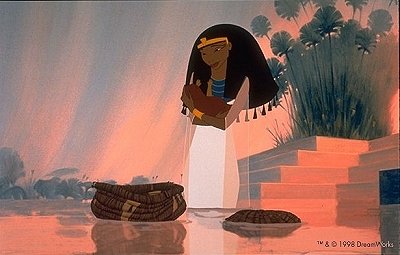 In
creating the faces, the character designers, along with lead animator William
Salazar, hit on an approach that further set their characters apart from
those in other animated films. Standard practice had been to divide the
faces into thirds: one third for the eyes and forehead, one third for the
nose and cheeks, and one third for the mouth and chin. In "The Prince of
Egypt," the familiar 33-33-33% formula was altered to 30-40-30%. Slightly
elongating the middle section of the face and shortening the upper and
lower ones gave the characters a more realistic and engaging countenance,
and allowed the animators to bring out more expression in their faces.
In
creating the faces, the character designers, along with lead animator William
Salazar, hit on an approach that further set their characters apart from
those in other animated films. Standard practice had been to divide the
faces into thirds: one third for the eyes and forehead, one third for the
nose and cheeks, and one third for the mouth and chin. In "The Prince of
Egypt," the familiar 33-33-33% formula was altered to 30-40-30%. Slightly
elongating the middle section of the face and shortening the upper and
lower ones gave the characters a more realistic and engaging countenance,
and allowed the animators to bring out more expression in their faces.
The designers also utilized color to accentuate the contrasts between the two cultures. The buildings of the Egyptians are in polished white and light pastels, while the homes of the Hebrews are in muted earth tones. Their costumes also reflect these color separations. The Egyptians are dressed in white with jewelry accents of gold, red and turquoise, while the Hebrews are clothed in natural shades of brown and beige. Only the Midianites, the desert tribe of Jethro and Tzipporah, are dressed in vibrant colors.
The Prince of Egypt is the first animated film to employ a professional costume designer. Kelly Kimball worked closely with the character designers to create a "wardrobe" for the characters. She did extensive research, and also experimented with fabrics and natural dyes that were available in the time of Moses. She discovered that the people of the day would have been able to achieve a full palette, which opened up the range of colors that could be used in the costumes.
 "There
are color cues we all respond to naturally," art director Kathy Altieri
explains. "We played on those throughout the film. The happier sequences,
for example, have lighter brighter colors with lots of sunlight streaming
through. We applied red and black for more dramatic, scary or violent sequences.
We used blue, a soothing color, in the scene when Moses' basket floats
into the Queen's water garden to emphasize that something nurturing and
safe is happening. The sequence of the death of the first-born is
almost monochromatic. Whereas we had used color saturation to fill a scene
with life, to express lack of life we literally sucked the color out. We
helped convey the emotions of the story through color, light and contrast,
but it should be very subliminal. If the audience becomes consciously aware
of it, we didn't do our job well."
"There
are color cues we all respond to naturally," art director Kathy Altieri
explains. "We played on those throughout the film. The happier sequences,
for example, have lighter brighter colors with lots of sunlight streaming
through. We applied red and black for more dramatic, scary or violent sequences.
We used blue, a soothing color, in the scene when Moses' basket floats
into the Queen's water garden to emphasize that something nurturing and
safe is happening. The sequence of the death of the first-born is
almost monochromatic. Whereas we had used color saturation to fill a scene
with life, to express lack of life we literally sucked the color out. We
helped convey the emotions of the story through color, light and contrast,
but it should be very subliminal. If the audience becomes consciously aware
of it, we didn't do our job well."
In animation, there is no set, so every sound has to be created from scratch, just like the visual elements. Award-winning sound designers Lon Bender and Wylie Stateman worked for over two years to develop the sounds of ancient Egypt, modulating the frequencies of the background noise in relationship to the action. The Red Sea sequence, for example, demanded that they give volume to the crashing waves without competing with Hans Zimmer's score. They did this by keeping their frequencies out of the range of the music, allowing the sound and the score to be harmonious. In the final step, re-recording mixers Andy Nelson, Anna Behlmer and Shawn Murphy wove together the sound effects, the music and, of course, the voices.
Steve Hickner notes, "The story is as timely today as it was 2,000 years
ago, and as it will be 2,000 years from now, as people continue to retell
the story in whatever media exists at that time."
|
||||||||||||